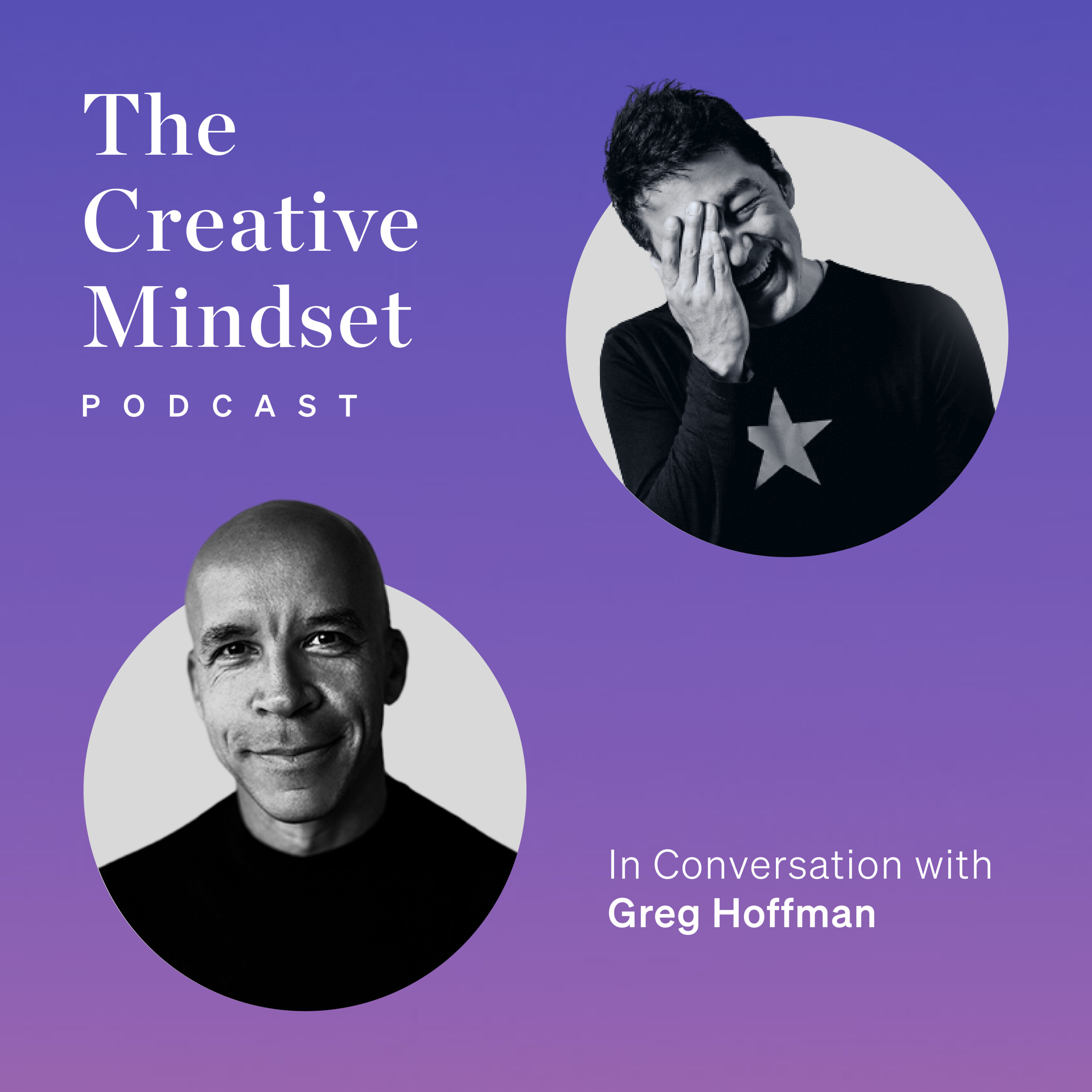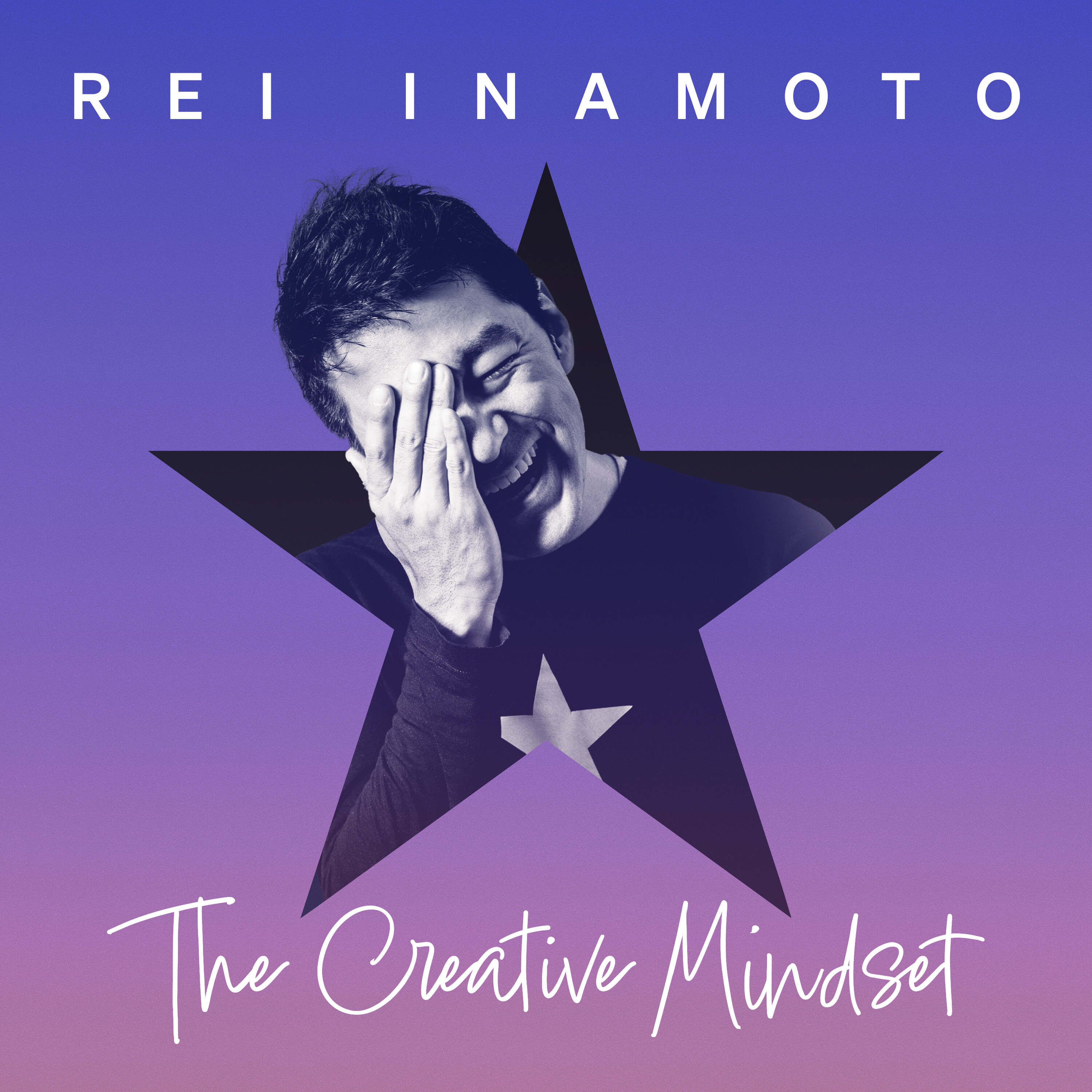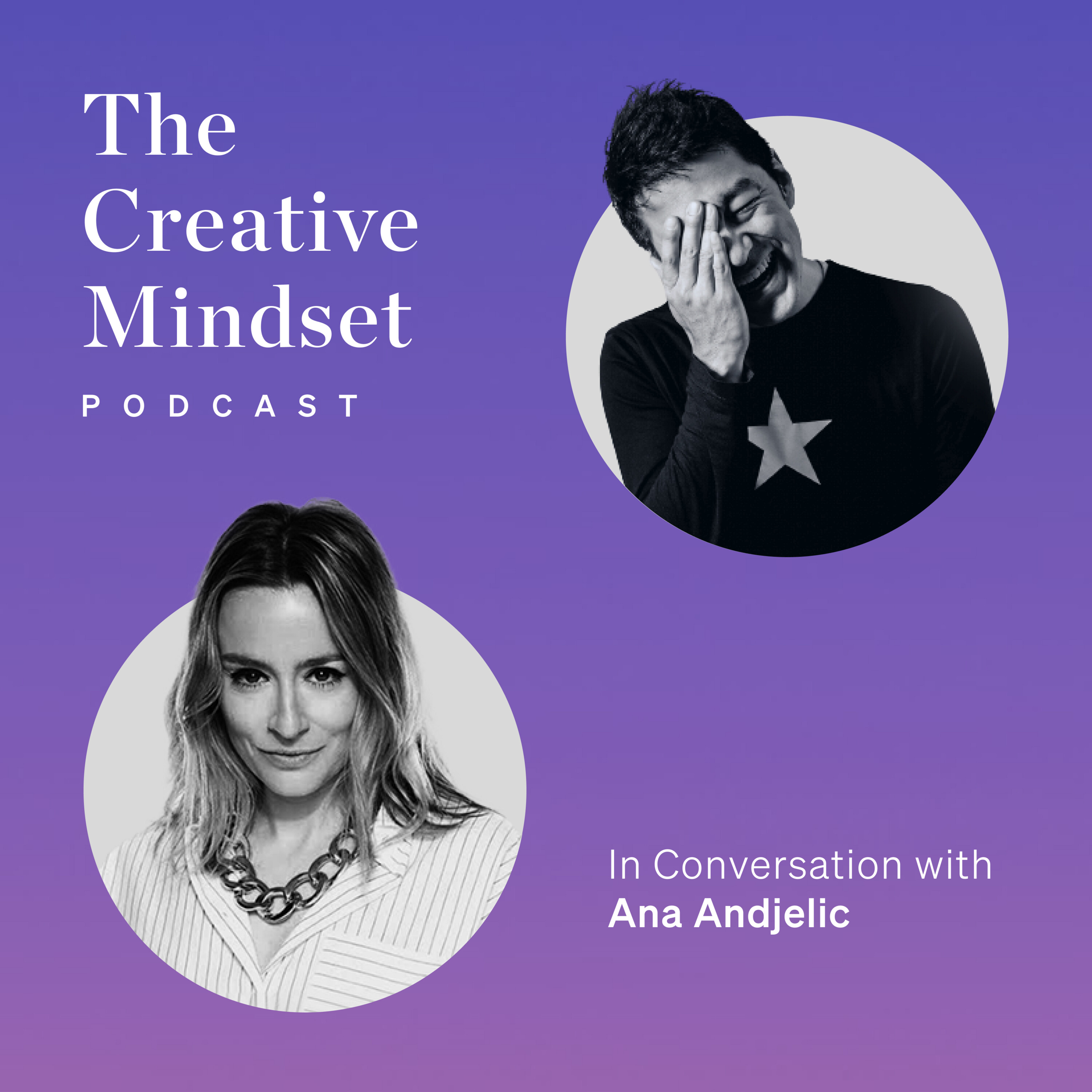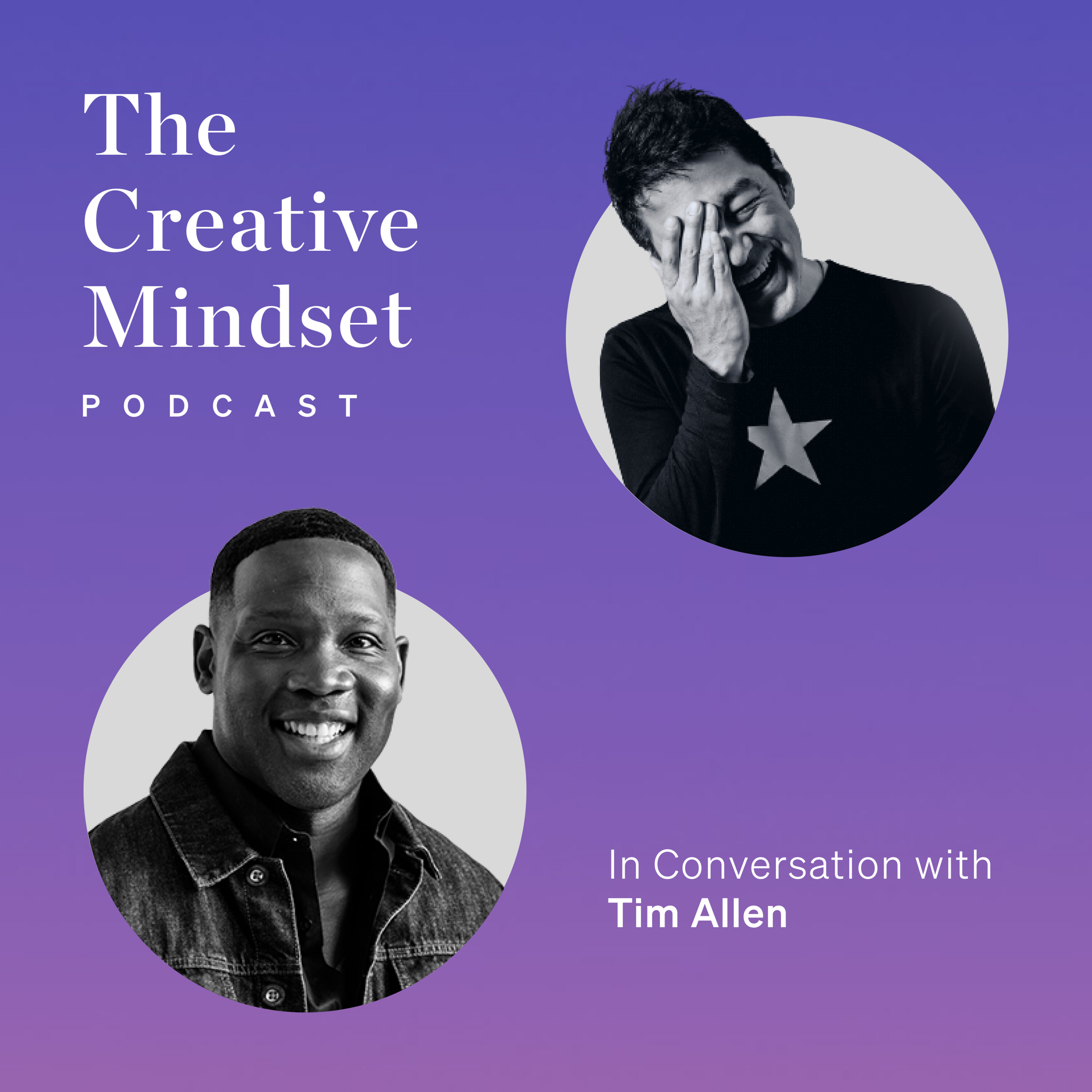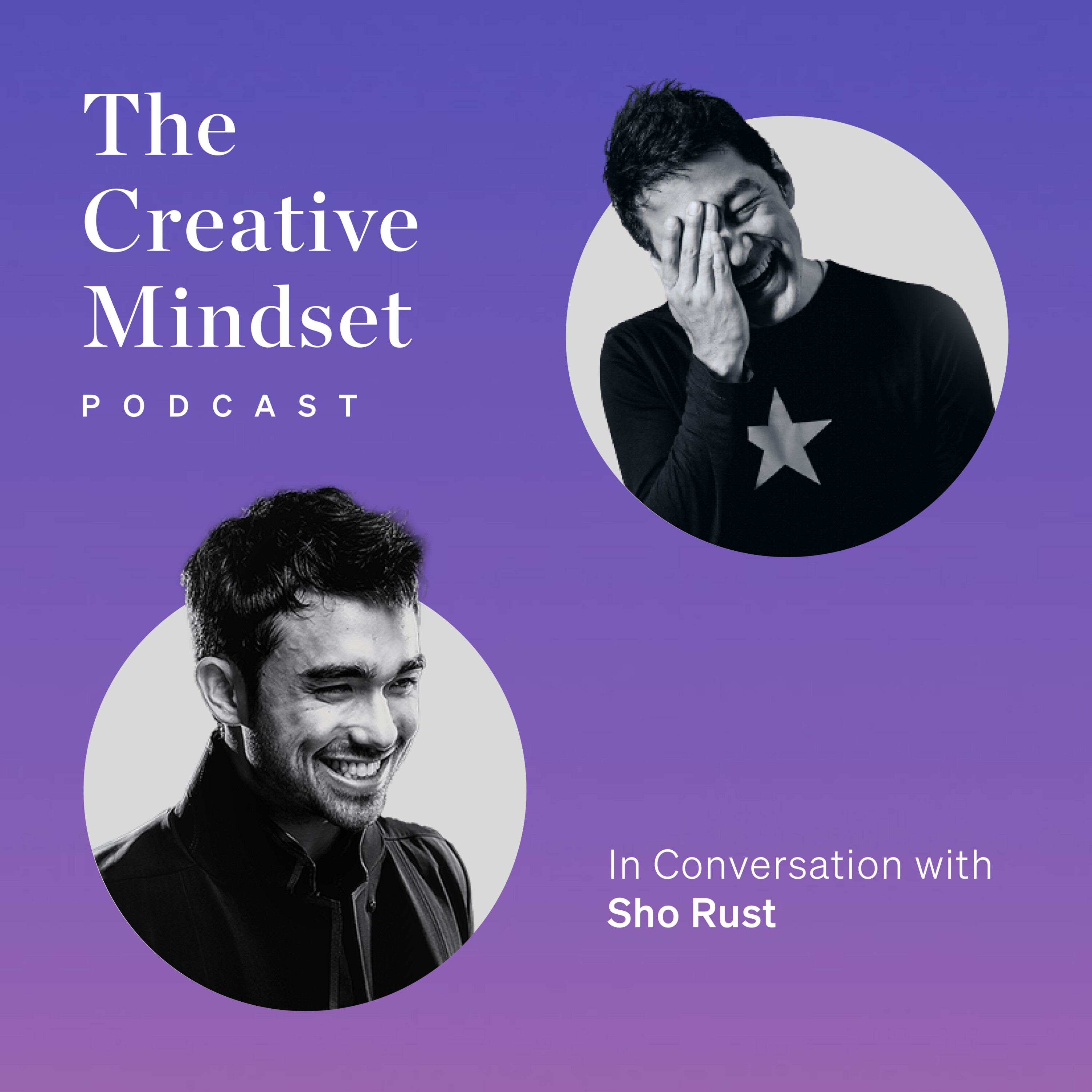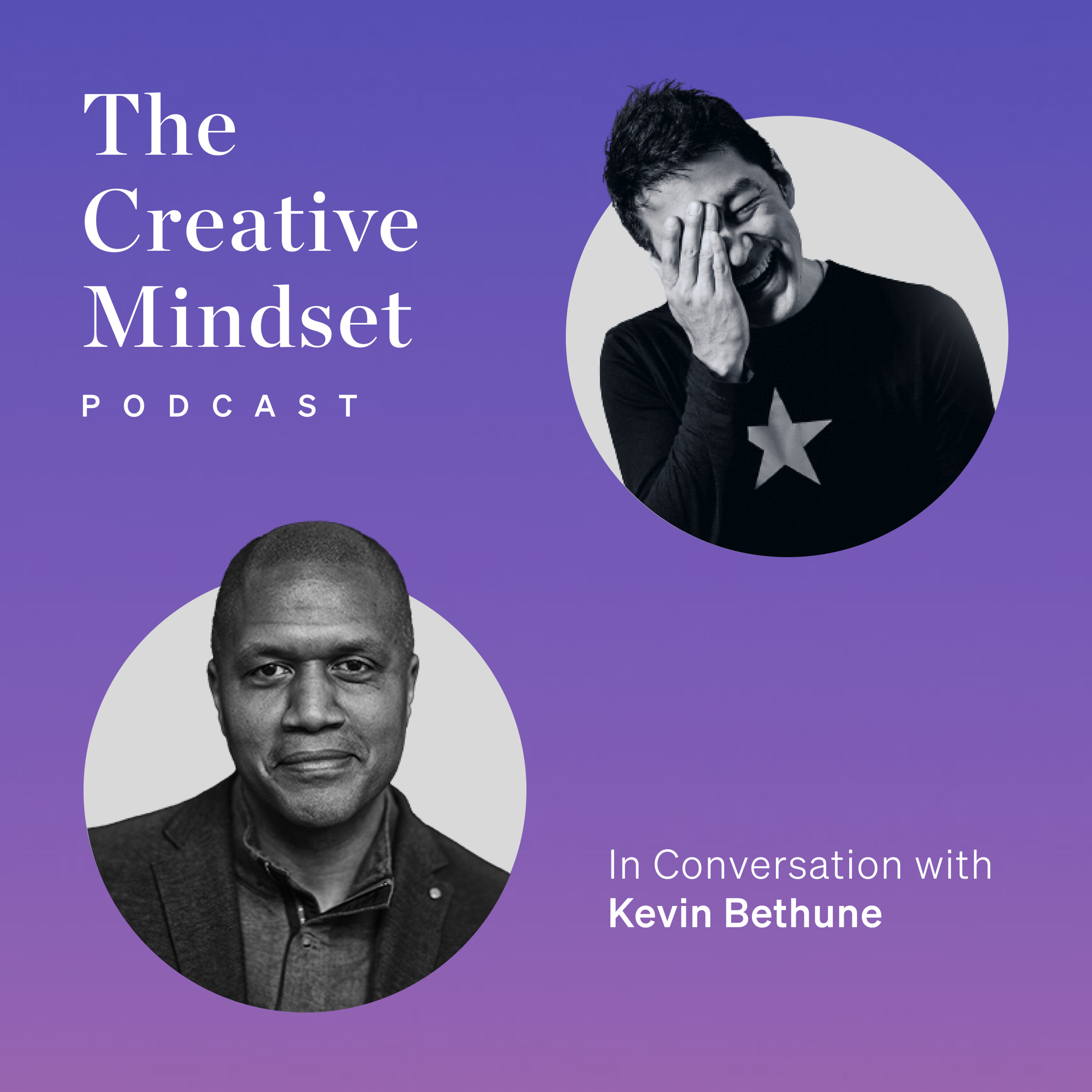This is Reinamoto's podcast, The Creative Mindset.
Hi, everyone. Welcome to The Creative Mindset, a podcast about what the future holds at the
intersection of creativity and technology. I am Reinamoto, the founding partner of I&CO,
a global innovation firm based in New York and Tokyo. Today's guest is Greg Hoffman,
the former chief marketing officer of Nike. In his 27-year tenure at Nike, he went from a design
intern to chief marketing officer. If you haven't listened to part 1 of my conversation with Greg,
please do have a listen. In part 2, we go into the work that he's been part of at Nike in close to
3 decades as well as the kind of risks he took to help build the brand to what it is today.
Also, he is one of the rare people who started their career in design and transitioned into
the business side of a corporation. You'll hear Greg talk about what he needed to do
to make that transition. So, let's get started. One point that you just mentioned that I would
like to pick up on is this notion of risk. And Nike is a brand known for taking a lot of risks.
In your 27-year tenure at Nike, what are some of the risks that you've taken as a leader and
as a brand that you think has worked out and has paid a dividend? And I would imagine if there are
risks, there must be risks that didn't pan out as you had imagined or as the team had imagined. So,
if you could talk about first some of the risks that you remember that you and or the team
deliberately took and it worked out great. And then maybe talk about a failed risk that you
might have encountered. Yeah, well, great question, right? And I'll go back to the beginning again
because when I showed up at the door at Nike and I went to the internship orientation.
And that is when we first heard the mantra, lead from the front.
And which means that you're going to go out first as a business or as an athlete and everyone else
is going to have to react to you, the competition, etc. And that was embodied, of course,
through Steve Prefontaine, the great distance runner at the University of Oregon and was Nike's
first sponsored athlete, right? Because that's how he ran. And so, that ethos of taking the risk,
leading from the front, carried through into the way the brand approached certainly innovation,
telling stories and engaging with customers in the world. And so, every step of the way,
I saw that idea of creative risk-taking come to life, certainly in culture. And just from
a personal standpoint, I was faced in 2010 with having to make a decision between do I go down
the design route and continue to grow in that lane or do I go down the marketing route? Because I was
always the hybrid, right? I have one foot in the world of design and that and I have one foot in
maybe more of the brand strategy route. And so, I never defined myself as either but I was faced
with having to make a decision at that point. And ultimately, I chose the marketing route because
I still felt that there was an enormous amount of creative leadership that you could drive
through the discipline of marketing, right? And so, that is when I started to move into
new roles with greater and more expansive responsibility over how the brand showed up
with its voice and identity throughout the world. But that's a risk, right? Because you're stretching
yourself and there's no guarantee with success. The other thing I would say here is before
the just do it slogan was created, Nike often used the slogan, there is no finish line, right?
And so again, just like within athletics, the same goes within business and innovation and that
you can always continue to pursue better. And so, I've never looked at failure as failure.
To me, failure is not only the price of innovation but failure is simply the steps
on the way to success. Because let's face it, the products and services that we covet the most
within our daily rituals on the way to achieve what we're using today, there are so many discarded
ideas and things that didn't work that led to that success, right? So, I don't mind using the
word failure as long as everyone understands that that's simply the price of innovation,
right? And at the end of the day, I want to be clear about this to anyone that's listening,
right? Is that you're taking risks on behalf of the customer. You're taking risks to create
solutions that are going to empower people or cities or communities to be better than they
were the day before. So, it's not just risk-taking for the sake of it, right? It's risk-taking in
service of others. And if you have that mindset, then the work that you put in, I believe,
is going to be more productive and ultimately more valuable for those you serve.
And so, oftentimes, look, when I think of risks, I think of concepts and projects that
weren't on a business plan. They weren't briefed. They oftentimes happened because a couple people
were in a hallway and decided to ask what if and why not. And so, I think of some of Nike's greatest
consumer concepts that is put out in the world, right? When I think of Nike's customization
shops that they grew during the, let's say, the 2000s, a lot of that was born out of a team
looking at other industries. And we actually looked at the Savile Row in London and how
fine suits are tailored by these master crafts people in the most personal way. And we simply
walked out of those stores experiences and we said, well, what would that mean
within the world of sneakers? And it started with one prototype of a sneaker customization shop
in New York, and then that grew to creating pop-up stores and studios in all of our flagship
resale stores. So, my point is that there is a risk with that, but someone's got to take the first step
and it's not always going to work. I think the best brands, the brands that I think are in
leadership positions when it comes to innovation, are the brands that are willing to go first,
right? And they understand that maybe only one out of four ideas is going to stick, right? It's
going to ultimately be adopted by your customer. But when it happens, it can be really impressive.
It's interesting to hear you say that you don't think of failures as failures. Those are moments
in time where things maybe didn't pan out as you expected, but in hindsight, it's interesting to
hear you say that you don't necessarily view them as, oh, this was a failed thing or that was a
failed thing, but just as a step to make something even better than what it was before. Yeah, that's
right. I always remind myself this, which is if you're a team that works within a brand or an
agency, how do you expect to take your customers someplace new if you're not willing to go there
first yourself? It's impossible, right? So, that's part of being a leader is taking that first step,
going out there first, even if it's a moonshot, right? And then inviting your customers,
your audiences to that audacious future, right? And so, again, if everything makes it out into
a marketplace, the digital or physical marketplace, well, you may be playing it too safe, right?
You may not be pushing far enough. You might be in that safe place. Maybe you're just simply
incrementally improving what you have, but you haven't necessarily taken that step where you're
creating a revolution within a particular category or industry. So, at the end of the day,
you have to incentivize risk-taking. And I talk about this in the book, but
I was around athletes and teams that did that, right? So, I was able to take a lot of inspiration
as well as my peers from what we saw in the world of sports. And there was one team over and over
again that embodied this idea of creative risk-taking or creative collaboration, which is
the Brazil national team. And not only were they successful, they're the only team with five
World Cups in the world of global football, the beautiful game. But it's not how many trophies
they've won, it's how they've won. And when many teams are just trying to create uniformity
and driving out all the individuality, here's this team that's actually celebrating the creative
eccentricities of each individual player coming together and allowing, having a game plan
and a playbook that allows a level of spontaneity and improv during the game
to produce amazing football. And oftentimes, that ends with a goal you've never seen before,
right? So, hey, at the end of the day, creativity is messy, right? And there's going to be times where
it literally drives you mad. But if you stick to that and you allow yourself to even be embarrassed
at sometimes, I think over time, having an aspect of your culture that at the end of the day,
a culture where people don't have to ask for permission to use their imagination, right?
People are allowed to dream, they're allowed to ask those questions, what if and why not?
And at the end of the day, yes, this is a business, and we have a responsibility to
drive that business. But one thing you can do is carve out time and space for teams to
work on things that are running parallel to the business plan, and then creating forums
where stakeholders are there to hear, listen, and feel new ideas, right? That may not necessarily
be on the plan. And I saw time and time again through that process that we were able to bring
things into the marketplace that carved out new territory for the brand and rewarded customers
for the passion that they had for our products. You talked about the Brazilian football team,
soccer team. And was there a moment or was there a game or was there a play that you saw
that made you go, wow, that's a risky move, or wow, that's a courageous thing that this player
did or that player did? What made you think that Brazilian team was this risk-taking creative team?
Look, a couple things here. One, it actually started in the 70s with me as a kid in the
suburbs of Minnesota, right? And opening up comic books, and there would be an ad with Pele,
you know, the greatest Brazilian football player ever. So as a kid, I'm seeing Pele,
and then seeing there's a movie called Victory. You can decide if you like that movie or not,
but Pele's actually in that movie and he does a bicycle kick, right? And so not only have you
seen Pele in your favorite comic books, now you're seeing Pele on the screen with none other than
Sylvester Stallone playing goalie, right? These are prisoners of war playing their German captors,
right? And a team of all-star football players versus the prisoners, okay? Well, Pele and
Sylvester Stallone are prisoners, right? So anyways, as a kid, I'm seeing this movie
in real life. And then ultimately really solidified by 1994 when Brazil won the World Cup
That's why Brazil is usually the number, the second most favorite team
in a given country, right? If you're talking national teams, because of how people feel
when they're watching them. Right. There's an episode in your book about the photo shoot that
you were doing with the Brazilian national team and how the fans started to get close and close
and you and your team were trying to protect the players, particularly I believe Ronaldo, right?
That's right. Could you talk a little bit about that and how you turned that into an additional
element of the work? I thought that episode, I knew about the campaign from the outside,
but I didn't know about the process that you went through and sort of created new elements to it
as you went by. My role was to lead a team to create the storytelling and brand identity for
the Brazil World Tour. Nike, partnering with Brazil, was going to go on the road and play
teams around the world to introduce this Brazil style of play to fans and audiences everywhere.
I went down to Brazil with two photographers and a film crew to capture footage for all the
different communication that we were going to have to create. While I was down there, the team
had an open scrimmage and training session at the stadium, but there really wasn't security there.
It was open really for the people of Goiânia, Brazil, which is one of the cities there.
As the training session and the scrimmage between the Brazil team was going on,
the stands kept getting more and more full. Around the field, there is a fence and there is a moat,
but the moat didn't have water. Theoretically, someone could climb down into the moat and
climb back up over the fence and then run on the field. You figure, okay, maybe one or two people
would try that. Here's the problem. It started with just one person, then two people, then 10
people, then 50, and then really, I mean, everyone was coming. We had finished our photo shoot,
they had finished scrimmaging, and we were all in the middle of that field as everyone started to
run towards the players. I was around Ronaldo. Our team basically made a ring around the players we
were doing the photo shoot around. You kind of got hit with full force of all these people.
At the end of the day, I looked down at Ronaldo because he was just stretching and relaxing after
working out. He basically looked at me, but I didn't really understand what he was saying.
At the end of the day, I got what he was trying to get through to me, which was let the people
through. Because at the end of the day, in some ways, it's like Brazil's success not only belongs
to the team, but it belongs to the people too. There's just this incredible connection
that these athletes have with the people of Brazil, where they've come from. They've come
from the same neighborhoods, streets, cities as well. There's this incredible unifying power
that football has, and the hopes and dreams of Brazilians carried on through these amazing
athletes. My takeaway from there, because I had a different idea of where I thought we could take
the Brazil World Tour campaign. Coming out of that, I thought, well, you know what?
It's going to be really, really important to also put the people of Brazil,
the fans that are so passionate about this team in the actual stories and communication.
From there, that really affected how I felt and how I steered and directed this
campaign. I think the result was pretty amazing because audiences everywhere got a view and access
to a side of Brazil they had never seen before. Because for the most part, you've been accustomed
to only seeing footage from games. Back to showing people your personality,
they'll respond to your humanity. I think we wanted to make sure we could show the personality
of the players, of the country, and of the fans. Then the reward, of course, is people around the
world back to this idea of creating an emotional connection. At the end of the day, you do
that by expressing human characteristics. Those characteristics and the way you reveal
those stories ultimately leave that mark in someone's heart or mind. I think that's
what that work did. I would imagine the fact that you captured not only the players,
but also the fans. But capturing the fans, if I understood correctly, wasn't part of the plan
initially, correct? No, it was not. We were there to follow the team around. We had access everywhere.
But at the end of the day, you have to be resourceful and you have to understand that, as I
said, there's two ways to a successful solution. You can take the linear path, the straight road,
or you can take the long and windy road like I usually do. This certainly was one of those
cases. You don't need permission to do that. You have to leave yourself open to adjusting
on the fly in real time. We certainly did in that standpoint. I believe we created
something that was far more profound. Yeah, because I think if you had planned it,
let's capture the audience, you'd have staged it somehow. Maybe the authenticity wouldn't
have come through if you had planned it and staged it.
That's right.
But the fact that it was an organic, almost an accident that happened.
Most of the fans breaking through the fences, climbing the moat and getting closer to the
players, that's a total potentially not so safe accident that happened. But really embracing
and creating that authenticity, it's not easy to plan that way, is it?
You're right. I've always said this, is that authenticity is paramount in terms of building
a brand that resonates around the world. Authenticity is your currency as a company and
as a leader in terms of how you show up and that people can connect what you do with who you say
you are. Authenticity comes from revealing a bit about who you are and who Nike is, oftentimes,
is revealed through these athletes and through these teams and through the power of sport and
the emotion of sport. Oftentimes, my role, our role, creatively, was to ensure that anchored
in the brand's authenticity as we strove to find new ways to communicate what you could say
are timeless themes of sport. Because that's the other thing. If you just show up every day and just
speak the same way in the same tone of voice, expressing the same traits, you're probably
going to get pretty annoying or boring, right? So, I think any person in any brand is a mosaic of
characteristics and you have to be conscious of what tone of voice you want to use within a given
year so that you're not repetitive, you're not boring, or you're not screaming the whole time,
right? So, you have to be cognizant of what's happening in the world, where the cultural
zeitgeist is, and make sure you're having those conversations and you're really clear on, one,
the traits and characteristics of your brand personality, but two, what aspect of your persona
do you want to reveal in that moment in time? Speaking of persona and cultural zeitgeist,
one of the recent campaigns that you talk about and that I'd like to bring up is Dream Crazy.
And going back to the earlier topic about taking risks, I mean, just coming up with a line like
Dream Crazy and, you know, if you believe in something, even if you risk everything,
is a risky proposition to make. So, during the course of the development of a campaign like that,
was there ever a talk internally about, hey, is this too risky? Or, hey, what are the potential
backlashes that we might get? Talk to us a little bit about the process of getting to that idea and
then releasing it and perhaps collocating risks that you as a creative leader and you as a
brand marketer may have taken. Yeah, it's a great question. I think it's important though to
understand that that work stood on the shoulders of a lot of work that had come before, right? And
you go back to 2006 when there was a lot of racism within the world of global football,
soccer, particularly in Europe. Racism between player against player, spectators against player
and coaches against player. And of course, it culminated with the Spanish national team coach
caught on tape saying something racially insensitive about Thierry Henry, right? Yeah.
And so he had had enough and so had others. And so working together, also with Nike,
we created the stand up, speak up campaign, right? And then let's fast forward to 2017
when we launched the equality campaign, right? Where LeBron utters those words,
why can't the ball bounce the same? The ball should bounce the same for everyone.
And that idea that why is it we're equals on the field or the court of sports, but when we
walk outside the white lines, we're not, right? So that's another example of amplifying the voice
of athletes and the experiences to help shape a better future for everybody. So by the time,
and of course, there's many other different examples, right? So my point is, is that
the brand had always been a champion to use the platform of sport and its position
to add something insightful to the conversation and also create action to try to drive that change.
And so fast forward to 2018, it's an opportunity to use the 30th anniversary of Just Do It,
right? To kind of look out into the world and use the moment to invite everyone to be a part
of this movement, to dream bigger, right? Because if you really look at that work,
that amazing work, and again, a shout out to Wyndon Kennedy and just all the amazing
copywriters and art directors and creative directors that work there. But at the end of the day,
we dream big and we dream out loud when we're kids, but over time, as we get older, we start to dream
less, we play it safer, we take less risks. And so it was really a moment in time to not only talk
about what Colin had experienced and was experiencing, but also connecting that across
a variety of different sports and people from all walks of life to really challenge the status quo
about what it means to dream and create something that was quite inspiring, was topical.
And was it a risk in the moment? Yeah, but again, I think it was just another example
of what the brand had always been doing. It was not out of character, it was its character to do so.
And certainly for me, it was a high point, right? As I write in the book,
I have a lot of similarities in terms of how I grew up to Colin, right? So when I was in that
first meeting on the Nike campus in 2017, when Colin came to campus and he didn't have an NFL
team to play for and we had a lunch, I was CMO at the time. And as I was sitting next to him,
I paused because we're both half white, half black. We're both mixed race. We were both
born to a teenage mother. We were both adopted by white parents and grew up in a predominantly
white suburb and or school system. And of course, in that journey, you're going to experience
moments and challenges of adversity, challenges that take form in racism, etc. And so in some
ways, you can't necessarily separate that personal experience from your professional one, right?
So when I'm in the room that day, I'm not just there as the CMO, I'm also there as the younger
self, right? And looking through those eyes. But the good news is there's a variety of others around
the table that are looking through a different lens. And that's the whole point is you're really
having objective conversations about the best way to tell a story in the most authentic way
that's going to reach the most people. When you're not having those conversations and there isn't
the level of objectivity, that is when you find yourself in a situation where maybe you're off
brand, right? And sometimes you look at work that makes it out into the world by certain companies,
and you can't believe it. But oftentimes, it's because everybody's way too close to the work.
Right? And it's important to have a voice of objectivity, even sometimes a dispassionate voice
in the room, right? Someone that isn't emotionally tethered to that idea. So you can really put it
through those filters to ultimately bring out something in the world that may not hit in the
moment, but over the long time is, as I said before, is never forgotten.
Excellent.
During the interview, we dig deep into different topics surrounding creativity.
On the contrary, with this section, we ask the same questions to the guests to react on the spot,
and we don't let them see the questions in advance.
Number one, if you weren't doing this, meaning branding, creative work, design, marketing,
what else would you be doing?
I'd be an architect. I have an addiction to modern architecture.
Question number two, if you could live anywhere in the world, where would you live?
I would say I have an affinity towards cities that are on bodies of water. So it most likely be
Barcelona or Sydney or Rio, somewhere where you have that, you know, the beauty of the ocean
meeting the land, and then maybe a little bit of history within the city itself.
Where is the next place that you'd like to travel to?
I really want to go to the mountains of Switzerland in the summer and hike between
the mountain towns. That's number one on my bucket list.
Question number four, your favorite food?
Well, I recently cut out pizza because just the cheese and gluten and everything. So just
trying to get a little bit healthier, but sushi continues to be one of my favorites.
What was the biggest turning point in your life?
I had a really amazing, arguably the number one design internship,
potentially in the world, in 1992 at the Walker Art Center.
This revered modern art museum that had this design department, and they gave out two
internships a year, and it was unbelievably competitive. And I got that, but I actually
left early to go back to Nike as a full-time employee. And that took a lot of guts and
something that you weren't supposed to do, but I did it. And that was a huge turning
point because at the end of the day, not only just did it lead to this career, but it's
where I met my wife. And through my wife, my two kids were born. So at the end of the day,
those are the most important things in my life. So that was the biggest turning point.
What is your superpower as an individual?
Well, I think it is my eyes, I guess, and the filter that I look through, and the way
I evaluate. And well, one, the way I take in what I'm seeing, but also the way I evaluate
it. Because at the end of the day, that's your role, you could say, as a creative director.
Your ability to look at a subject, look at work and shape it, and not necessarily through
your own hands, but through your voice and through the hands of others, if you will.
But again, that fits back into that idea of curiosity and not just taking details for
granted.
That was part two of my conversation with Greg Hoffman, the former chief marketing officer
of Nike and the author of Emotion by Design. So here are my three key takeaways from
this part of my conversation with Greg.
Key takeaway number one, always on the offense.
Number two, it's not just the fact that you win, but it's how you win.
And number three, be human, design emotion, and leave your legacy.
Key takeaway number one, always on the offense.
This is actually one of the maxims that Nike has inside the company.
One episode that I thought would illustrate this point, always on the offense,
is a recent initiative that Greg was part of called Dream Crazy,
in which Nike features Colin Kaepernick, who was protesting police brutality against
black men in the United States.
He essentially risked his career to make a stand, to make a statement for something that
he believed in.
And it's something that Greg, also as a black person growing up in the United States,
and facing a lot of different types of racism throughout his life,
he felt, Greg felt that it was important for him to be part of something like that.
And if you think about Dream Crazy, I mean, for a multi-billion dollar international corporation
to say Dream Crazy is not the easiest thing to do.
There are many, many risks associated with making a statement like that.
But as the statement, as the tagline, Dream Crazy goes, and the additional story that
Nike told with Colin was that they encouraged people, and particularly young people,
to believe in something, even if you risk everything.
I appreciated the fact that they took the risk to say something that they really believed
in.
Key takeaway number two, it's not just the fact that you win, but it's how you win.
He also had an example to illustrate this point.
And he used the Brazilian football slash soccer team.
If you are remotely into soccer or football, you know that different teams and different
countries have different styles of play.
In the late 90s, I believe, Nike decided to sponsor the Brazilian, the national team,
and they designed their uniform, and they had the rights to use the Brazilian team to
promote their business.
But the fact, the reason why Nike chose Brazil as the team to support and really represent
Nike as a brand is because of the style of play that many Brazilian players had.
And it's called Jinga, which means sway in English.
But this idea of Jinga is infused into the way every Brazilian player plays, and the
Brazilian team, even different generations of Brazilian teams, have this kind of sway.
So it's not just about the fact that you win the game, but they play with style.
They play and they win with Jinga.
So it's not just the fact that you win, but it's how you win.
Key takeaway number three, be human, design emotion, leave your legacy.
I don't really need to say anything much on this statement.
This is the summary of the book.
It's the last phrases that Greg uses to summarize and encapsulate the essence of the book.
And these three phrases, be human, design emotion, leave your legacy, in many ways,
they say everything that Greg wants to say and everything I wanted to take away from
him distilled into just a few words.
Be human, design emotion, leave your legacy.
That is the lesson that Greg imparts to us, and I hope you take something away from it.
If you're listening to this on Spotify, there's a Q&A field, so please do send us
your questions and comments.
If you are listening to this on Apple Podcasts or any other app, and if you like our podcast,
please leave us a five-star rating.
It really helps, and we'd be so grateful.
In the next episode, we continue my conversation with Greg, and the focus is on taking risks
in brand communication.
I'm Reina Moro, and this is A Creative Mindset.
See you next time.
